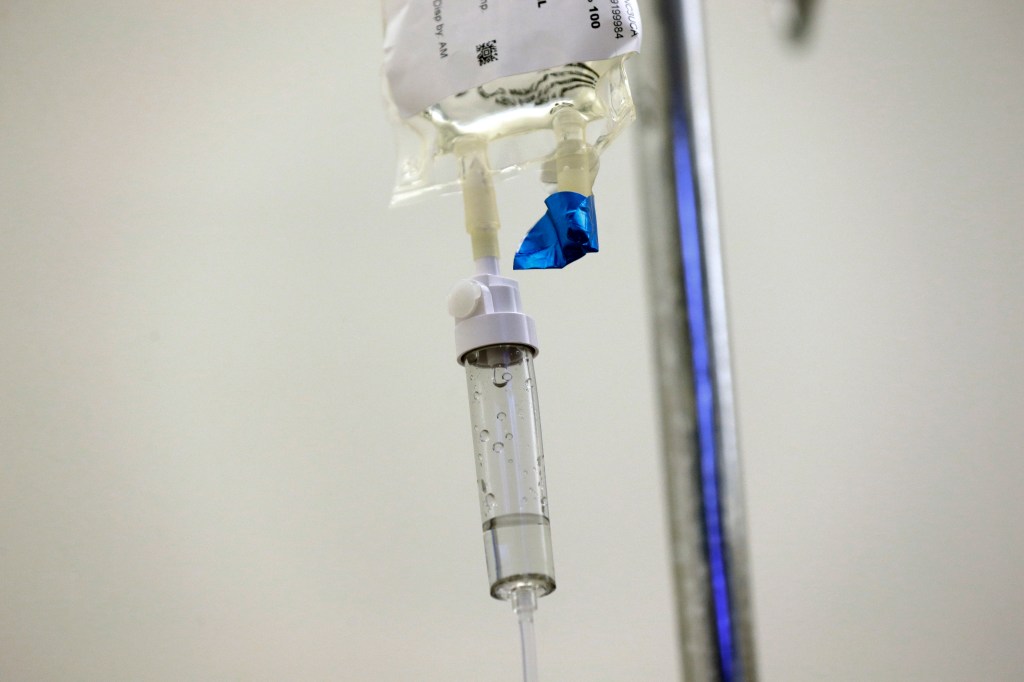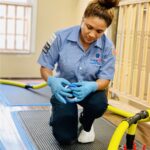
Colorado cancer centers try to manage chemotherapy drug shortage
Last Updated on August 6, 2023 by Admin
[ad_1]

Two workhorse chemotherapy drugs are increasingly hard to come by, and Colorado cancer centers are trying to manage the shortages with as little effect on patients as possible.
A May survey of 27 U.S. cancer centers found 25 were short of carboplatin and 19 were short of cisplatin, generic drugs that use the metal platinum to stop cancer cells from growing. About 36% of centers reported that they weren’t able to offer all eligible patients carboplatin promptly and at the optimal dosage.
Dr. Leslie Busby, chairman of pharmaceuticals and therapeutics at the US Oncology Network, which manages drugs for Rocky Mountain Cancer Centers’ 19 Colorado locations, said that during the worst point of the cisplatin shortage, they prioritized giving the limited doses to patients with testicular cancer, because it gives them a good chance of being cured.
Some people who had other cancers or were unlikely to be cured were switched to carboplatin or another drug, Busby said. That’s in line with a recommendation from the American Society of Clinical Oncology to prescribe drugs in shortage to patients who have a good prognosis if they receive them.
Now, among the two infusion drugs, the cisplatin shortage has eased somewhat, but carboplatin is difficult to come by, Busby said. Since cisplatin can cause kidney damage, the US Oncology Network alerted doctors to save their carboplatin doses for patients who are at higher risk for kidney disease, and to use smaller doses and space treatments four weeks apart instead of three, he said.
“The biggest fear we have is stocking out (of the drugs) entirely and not being able to treat,” he said.
Other cancer drugs also are in shortage, but the difficulty in getting carboplatin and cisplatin is affecting the most patients. The National Cancer Institute estimated between 10% and 20% of cancer patients take platinum-based drugs. They are used in breast, lung, ovarian and testicular cancers, among others.
Doctors regularly substitute chemotherapy drugs or adjust dosing schedules depending on patients’ individual needs, but there hasn’t been much research on some of the changes they’re having to make due to shortages, Busby said. The uncertainty is compounding the stress for some patients already facing a difficult diagnosis, he said.
“Sometimes, when people have cancer, their anxiety is already skyrocketing,” he said.
“There are shortages that are happening all the time”
Infusion medications given for chemotherapy aren’t the only drugs in short supply.
In the past year, patients have reported difficulty getting drugs to treat attention deficit hyperactivity disorder, certain antibiotics, children’s fever medicines and growth hormone for kids whose bodies don’t produce it naturally. Each situation was slightly different, with some shortages primarily blamed on manufacturing issues, while others were due to high demand.
The supply chain for generic drugs can be fragile, since they aren’t especially profitable to produce, giving manufacturers little incentive to maintain existing facilities or invest in new ones. Industry watchers raised alarms after a tornado ripped the roof off a Pfizer facility in North Carolina in July, because the complex produces about one-quarter of the sterile injectable drugs that the company sells to U.S. hospitals. While the damaged facility was a warehouse rather than a plant, Pfizer still announced that 30 drugs could be in short supply in the coming months.
After the Pfizer facility was hit, UCHealth put together a team to figure out what that would mean for their supply of injectable drugs, said Amy Gutierrez, chief pharmacy officer at the health system. Generic drugs are cheap, and manufacturers want to use their space for the most profitable medications, particularly when that space is set up for the more-complex process of producing sterile drugs, she said.
“You will probably never find a shortage in an expensive, brand-name drug,” she said. (An exception is new weight-loss drugs, which have faced overwhelming demand.)
So far, UCHealth has been able to handle the current shortage by predicting how many doses of chemotherapy drugs it will need in the near future and shifting inventory between its hospitals as needed, Gutierrez said.
“Knock on wood, we haven’t had to deny a patient a drug yet,” she said.
Chris Nagy, medication sourcing and supply pharmacist at Intermountain Health, said he doesn’t know of any patients who’ve had their chemotherapy doses postponed or changed at the system’s hospitals in Colorado and other western states. It helps to be part of a large group, because hospitals can send drugs back and forth, depending on who needs what at any given moment, he said.
Given the recurrent shortages, though, moving drugs around isn’t always enough, Nagy said. He estimated Intermountain stockpiles a roughly 30-day supply of about 150 of the 3,000 medications that a typical hospital may have, including multiple formulations of some of them. The decision on which to keep on hand was based on how commonly the drug is used and how severe the consequences would be if a hospital ran out, he said.
A Congressional report on drug shortages found 295 medications were in short supply at the end of 2022, an increase of about 30% from 2021. The average shortage lasts about 18 months, but a handful of drugs have been listed as in shortage for more than a decade.
The report blamed the increase in shortages on overreliance on a few suppliers, particularly those based in China and India; limits on the U.S. Food and Drug Administration’s ability to collect data that would help predict shortages, and difficulty using the data it has; and increased demand for some drugs.
Shortages have been a problem for two decades, but it’s only recently that the public has noticed, Nagy said.
“We’re getting very tired of doing this and nobody knowing,” he said. “There are shortages that are happening all the time.”
No government help
The shortage of the chemotherapy drugs cisplatin and carboplatin started after inspectors from the FDA found trash bags of shredded documents that showed quality problems at a manufacturer in India that produces about half of the cisplatin used in the United States. The facility also produced carboplatin.
The FDA has allowed a supplier in China that is registered with the agency but hasn’t completed its full process to temporarily ship cisplatin to U.S. providers, and left the door open on possibly importing carboplatin.
Manufacturers often don’t provide any detail about why a drug is in short supply, simply saying it’s on backorder, Nagy said. Knowing whether the problem is transient or something that could last for months would make it easier to respond, he said.
Drugmakers also need more incentives to manufacture generics, and more help if they get into trouble, Nagy said. Banks that are failing may get help to avoid disrupting the financial system, but there’s nothing like that for health care, he said.
“The federal government doesn’t come in to help them,” he said.
Intermountain’s strategy now is to take on slightly higher costs from manufacturers that guarantee a steady supply, and to keep a stockpile of the most important drugs, Nagy said. In the worst cases, the health system sometimes has to buy from “secondary wholesalers,” that purchase drugs that are in shortage and resell them at a higher price, he said.
Generally, businesses want to have inventory right when they need it, to keep down the cost of managing a stockpile. That contributed to shortages of personal protective equipment and consumer products early in the pandemic, when demand suddenly increased, and was exacerbated by hoarding.
“We all learned during COVID that just-in-time (ordering) doesn’t work for toilet paper. It doesn’t work for oncology agents either,” Nagy said.
Sign up for our weekly newsletter to get health news sent straight to your inbox.
[ad_2]
Source link




